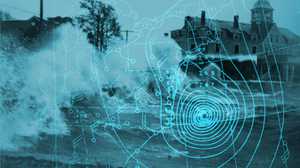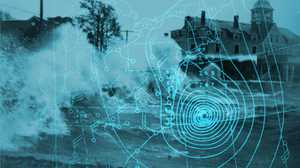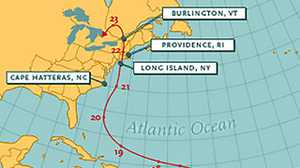U.S. Storm Disasters

1635
The Great Colonial Hurricane sweeps across southern New England on a path west of Providence, Rhode Island, and Plymouth, Massachusetts. Narragansett Bay floods, drowning 17 Native Americans; tree damage is severe throughout southeastern Massachusetts. Governor William Bradford described the storm: "such a mighty storm of wind and rain as none living in these parts, either English or Indian ever saw. ...It blew down sundry houses and uncovered others. ...It blew down many hundred thousands of trees turning up the stronger by the roots and breaking the higher pine trees off in the middle."
1803
After a fire in New Hampshire, the United States Congress offers disaster relief aid for the first time. This legislation will eventually lead to the formation of the Federal Emergency Management Agency.
1815
The Gale of 1815 sweeps across New England, again flooding Providence, Rhode Island, and causing immense losses along the coast and in the shipping industry.
1842
James P. Espy is named the government's first official meteorologist.
1869
A Mr. Saxby foresees a "severe storm" and soon thereafter, by coincidence, a hurricane lashes eastern Maine and the Bay of Fundy. This is the last major tropical system to cross the New England coast as a destructive hurricane until the 1938 Hurricane. It is named Saxby's Gale.
February 9, 1870
President Ulysses S. Grant orders the secretary of war to record weather observations from sites across the United States. In 1873 reports are added from posts in the Caribbean that allow for better forecasts of hurricanes.
October 1, 1890
Congress passes legislation changing the Army Signal Corps weather forecasting operation into a civilian service, the Weather Bureau, within the Department of Agriculture.
1893
Six hurricanes hit the United States in one year, killing a total of 4,000 people.
September 8, 1900
A hurricane hits Galveston, then the wealthiest city in Texas, leaving between 6,000 and 8,000 residents dead. This remains the worst weather disaster in American history, as measured in lost lives.
April 18, 1906
An earthquake in San Francisco is followed by four days of a devastating fire. An estimated 3,000 lives are lost and damage is estimated at $500 million in 1906 dollars.
March 1, 1910
An avalanche at Wellington, northeast of Seattle, Washington, sweeps two trains -- a mail train and a passenger train -- off a mountain pass through the Cascades, killing 96 people.
March 18, 1925
A tornado touches down in Missouri and sweeps through Illinois and Indiana before dissipating. In three hours, the Tri-State Tornado kills 695 people.
September 18, 1926
The 'Big Blow" crashes into the nation's hottest vacation spot, Miami Beach, Florida, surprising residents who have ignored forecasts. In the aftermath, the lobbies of prestigious Collins Avenue hotels are covered in sand, 253 people are dead, and at least 25,000 people are left homeless.
1928
After devastating Puerto Rico, a ferocious storm whips ashore at Palm Beach, Florida. Rain from the hurricane fills Lake Okeechobee, Florida, causing major flooding. In the storm's aftermath, 1,836 people are dead.
September 2, 1935
The most intense Category 5 Atlantic hurricane ever to touch down in the United States roars into the Florida Keys. The "Great Labor Day Hurricane" kills 408 people.
September 21, 1938
A devastating hurricane drives through the northeastern United States. Residents are unprepared for the storm and the flooding it brings. Over 600 people are killed, most by drowning. Another hundred are never found. Property damage is estimated at $300 million — over 8,000 homes are destroyed, 6,000 boats wrecked or damaged. Yet the hurricane does not receive much media attention; Neville Chamberlain's appeasement of Adolf Hitler in Europe dominates headlines before and after the storm.
1940
The Weather Bureau is relocated from the Department of Agriculture to the Department of Commerce.
April 1, 1946
An earthquake in Alaska triggers a wave of energy that eventually forms into a tsunami that hits Hawaii. One hundred and fifty-nine people are killed, many of them children curious about the receding waterline that signals the oncoming wave.
1950
Hurricanes begin to be named alphabetically with the radio alphabet: Able, Baker, Charlie, Dog, etc.
1953
The National Hurricane Center establishes a system for naming storms, using alphabetical lists of women's names. Rather than repeat names every year, enough names are used so that a single list of names is recycled every six years, although storms that cause significant damage or loss of life have their names "retired."
August 7-21, 1955
Hurricane Diane assaults the east coast, killing 187 people.
March 6, 1962
The "Ash Wednesday Storm" slams against the East Coast from North Carolina to New England, leaving hurricane-like devastation.
August 17-18, 1969
Hurricane Camille, one of only two Category 5 Atlantic hurricanes to make landfall in the U.S., blasts Mississippi and Alabama, causing $1.4 billion in damage.
1970
The Weather Bureau is renamed the National Weather Service, and becomes part of the National Oceanic and Atmospheric Administration within the Commerce Department.
June 16-25, 1972
Hurricane Agnes, a relatively weak but large weather pattern, hits Florida and moves northward up the East Coast, causing floods in Pennsylvania and New York, killing 115 people and causing $2.1 billion in property damage.
1979
The system for naming hurricanes evolves to include men's names, as well as names of English, Spanish and French origin. Since 1981, the naming system has been administered by the World Meteorological Organization, an international committee.
September 12-13, 1979
Hurricane Frederic assaults Mississippi and Alabama, causing $2.3 billion in damage.
August 18, 1983
Hurricane Alicia makes landfall at Galveston Island, Texas, unleashing 23 small tornadoes. The storm kills 21 people, leaves Houston littered with tree limbs and broken glass, and causes $2 billion in damage.
October 26 - November 1, 1985
Hurricane Juan devastates south central Louisiana and coastal Texas. Though only rated a Category 1 storm, Juan racks up $1.5 billion in damage, and kills 63 people.
September 8-19, 1988
Hurricane Gilbert generates the lowest sea level pressure (888 millibars) to be recorded in the Western Hemisphere -- but by the time it reaches land at Cozumel, Mexico, its intensity has subsided. Moving northward, Gilbert takes the form of a major rainstorm over Texas and Oklahoma, spawning 29 tornadoes and killing three people.
September 17-25, 1989
Hurricane Hugo slams the U.S. Virgin Islands, Puerto Rico, Florida and South Carolina, causing $7 billion in damage. At the time, it is the costliest hurricane ever to hit the nation, though loss of life is limited.
August 19, 1991
Hurricane Bob affects North Carolina, New York, and New England, destroying 32 of 35 shorefront homes in Angelica Point, Massachusetts, blowing 125 mph wind gusts through the Cape Cod towns of Brewster and North Truro, and leaving $1.5 billion in damage in its wake.
August 24, 1992
Hurricane Andrew sweeps through Florida and Louisiana, causing $26,500,000,000 worth of damage (in 1992 dollars), more than any hurricane before.
September 11, 1992
Hurricane Iniki, birthed from the El Niño weather phenomenon, hits one of the Hawaiian islands, Kauai, killing seven people and damaging an estimated 90% of the island's wood-frame buildings.
October 3, 1995
Hurricane Opal makes landfall just south of Pensacola, on Florida's Panhandle. Nine people are killed in Florida, Alabama, Georgia, and North Carolina, all but one by falling trees. In Opal's wake, $3 billion in property damage is assessed.
September 5, 1996
Hurricane Fran blows into Cape Fear, North Carolina, wreaking havoc on coastal towns, homes, and trees, and racking up $3.2 billion in property damage.
September 6-19, 2003
Hurricane Isabel brings flooding, 100-mph winds, and power-outages to North Carolina, Virginia, and much of the Mid-Atlantic. 6.5 million households lose electricity during the storm.
August 28, 2005
Hurricane Katrina claims an estimated 1,400 lives and causes over $100 billion in property damage. It is the costliest hurricane in U.S. history.
September 1-14, 2008
Hurricane Ike's landfall in Galveston, Texas, results in the largest evacuation in Texas state history.









